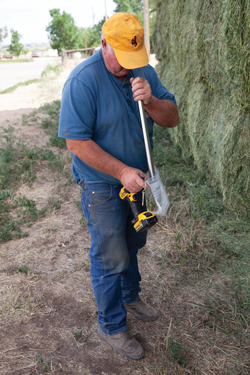The author is a beef cattle specialist for Texas A&M AgriLife Extension based in Overton, Texas.

A forage test, or a hay test, is normally taken to primarily evaluate the energy and protein content of hay, silage, or baleage. However, it can be a good tool to also monitor mineral concentrations in the forage and help evaluate your fertilizer program. Are some minerals being applied in excess? Overapplication is costly and, in some cases, can lead to animal health issues, reduced animal performance, and even contribute to death loss.
Calcium and phosphorus
Poultry litter and animal manure can be cost-effective options to apply nutrients to soils that are deficient in phosphorus and potassium. However, most forages have a low requirement for phosphorus. Continuing to apply poultry litter, animal manure, or other sources of phosphorus after nutrient levels build up is not cost effective and can be detrimental from a livestock standpoint. Additionally, if soil erosion occurs, excess phosphorus can move off site into rivers and streams. Looking at the calcium and phosphorus levels from a hay test is a good way to help monitor phosphorus levels.
Depending on the species and seed content of the sample, calcium levels in forage will generally average from 0.2% to 1.5% on a dry matter basis. Legumes will have higher levels of calcium than grasses. Phosphorous levels will average between 0.18% and 0.40% on a dry matter basis.
Just as important as the level of each mineral is the ratio of calcium to phosphorus. One bermudagrass study showed calcium averaged 0.48% and phosphorus averaged 0.21% based on results from over 21,500 samples. This resulted in a calcium to phosphorus ratio of 2.3-to-1.
Excess phosphorus application can result in a drop in calcium levels and a rise in phosphorus levels, both of which can have negative effects. In most cases when the calcium to phosphorus ratio drops below 1.4-to-1 on a hay test, phosphorus applications should discontinue or be greatly reduced. In severe cases where the phosphorus level is higher than the calcium level, phosphorus applications must be stopped. These high phosphorus levels greatly enhance the risk of milk fever, urinary calculi, and other health problems in cattle, which can result in death. High phosphorus levels in forage can also reduce the absorption of calcium by animals, which can lead to reduced growth rates.
Excess sulfur
Sulfur is a mineral that is needed by both plants and animals for normal growth. Sulfur is often included in fertilizer programs to help boost crop yields. However, overapplication of sulfur likely will not benefit yields and can have significant impacts on cattle health and performance.
Cattle require a diet with about 0.15% sulfur on a dry matter basis. However, sulfur can become detrimental once levels exceed 0.3% to 0.5%, depending on the diet, animal age, and other mineral levels. If sulfur levels in forage exceed 0.3%, reduced sulfur applications are likely warranted. If sulfur levels exceed 0.5% in forage, applications of sulfur must stop until levels drop. The frequency and rate at which sulfur needs to be applied will depend on rainfall and soil type.
Sulfur levels in forages generally range from about 0.1% to 0.43% on a dry matter basis. Out of a study on more than 50 forage sample categories, bermudagrass hay had the highest average sulfur content at 0.43%. This suggests that sulfur was routinely overapplied to many bermudagrass hayfields.
Luxury consumption
Potassium is a mineral that some forage species may consume in excess. Luxury consumption is problematic because it doesn’t improve yields for the current cutting of hay or baleage and it reduces the amount of potassium available for future cuttings.
Recent hay test results from the first and second cutting of teffgrass illustrate this. Potassium fertilizer was applied during the winter. The potassium level from the first cutting was 3.24% and the potassium level from the second cutting was 1.7%. Potassium levels above 2% in forage likely won’t result in better production.
The rate of potassium fertilizer breakdown and subsequent movement into the soil will vary with rainfall, temperature, and soil type. Potassium breaks down and moves into the soil at a much quicker rate in warm, high rainfall areas. As such, the frequency and rate at which potassium should be applied will vary.
In higher rainfall environments, consider applying some potassium after each cutting to improve the efficiency of your fertilizer program without increasing the total amount of potassium applied for the year.
At major forage testing labs, calcium, phosphorus, potassium, and sulfur are included as part of a basic near infrared reflectance spectroscopy (NIRS) forage analysis. While NIRS is not as good for analyzing minerals, it is sufficient for routine monitoring of macronutrients. If a potential issue is identified, a wet chemistry minerals package can be requested to confirm macronutrient levels and to evaluate trace mineral levels.
The next time you send in a hay test to help develop a feeding plan for your livestock, consider what it can tell you about your fertilizer program.
This article appeared in the March 2025 issue of Hay & Forage Grower on page 28.
Not a subscriber?Click to get the print magazine.

